Living with a Disability: Support and Resources Today
Living with a disability can change your life in big ways. It makes you see yourself and the world differently. You’re not alone in this journey. The Centers for Disease Control and Prevention (CDC) says 1 in 4 Americans have a disability.
Accepting a disability takes time. You might grieve for what you’ve lost and look for new ways to live. Learning about your condition and finding support is key to living well.
There are many resources to help you thrive, whether you’re new to a disability or have lived with one for years. Look for organizations, technologies, and healthcare that fit your needs.

Key Takeaways:
- 1 in 4 Americans lives with a disability, highlighting the importance of understanding and addressing the unique challenges faced by this community.
- Acceptance and adaptation to a disability is a process that involves learning about your condition, setting realistic goals, and seeking support from loved ones and professionals.
- A wide range of resources and support systems are available to help individuals with disabilities navigate everyday life, from healthcare and financial assistance to assistive technologies and community organizations.
- Engaging in activities that bring happiness and meaning, as well as joining disability support groups, can be valuable in maintaining good mental health and combating feelings of isolation.
- Accessibility and inclusion are key considerations in ensuring individuals with disabilities have equal access to information, services, and the built environment.
Understanding Disability and Its Impact
Disability can be physical, cognitive, sensory, or mental health-related. In the United States, millions face daily challenges due to their disabilities. It’s important to understand their disability rights, disability services, and inclusion needs to support them effectively.
Types of Disabilities and Common Challenges
Disabilities include mobility, visual, hearing, learning, autism, and mental health issues. People with disabilities often face barriers in accessibility, communication, and social integration. This can lead to poorer health, lower education, and higher unemployment and poverty rates.
Statistics and Demographics in the United States
About 20% of the U.S. population has a disability at some point. Disabled individuals often face social and economic disparities. Factors like race, ethnicity, and language make it harder for them to access disability services.
Social and Economic Effects
The social model of disability says the biggest barrier is the environment, not the disability. Old models like the Medical and Charity Models limit opportunities for disability rights. It’s key to address these issues to promote inclusion and empower individuals with disabilities.
More than 1 in 4 U.S. adults has a disability, says the CDC. The CDC’s Disability and Health Data System (DHDS) offers insights into this population’s demographics and experiences.
“The social model of disability emphasizes that the most significant barrier for individuals with disabilities is the environment, rather than the disability itself.”
Good communication and language choice are vital for understanding and respecting people with disabilities. Using people-first language is recommended to focus on abilities rather than limitations.
Adapting to Life with a Disability
Life with a disability is a journey of resilience and adaptation. It’s about embracing your new reality and focusing on what you can do. Finding ways to lessen the disability’s impact on your daily life is key.
Being your own advocate is crucial. Use adaptive technologies and tools to your advantage. Setting realistic goals helps you become more independent.
Patience is essential during this journey. Accepting your disability and finding ways to manage it empowers you. Staying connected with others helps fight feelings of isolation.
- Embrace your new reality and focus on what you can do, not what you can’t.
- Advocate for yourself and utilize adaptive technologies to enhance your independence.
- Set realistic goals and be patient with the learning and adaptation process.
- Maintain strong social connections to combat feelings of isolation.
By being proactive and using available resources, people with disabilities can thrive. With the right mindset and support, adapting to a disability can be transformative. It fosters personal growth and appreciation for the human spirit’s resilience.
“The greatest glory in living lies not in never falling, but in rising every time we fall.” – Nelson Mandela
Essential Support Systems and Services
Life with a disability can be tough, but there’s help available. There are key support systems and services for people with disabilities and their families. These help improve life quality, increase independence, and offer help in healthcare, finances, and community activities.
Healthcare Resources and Medical Support
Good healthcare is key for those with disabilities. Disability services include special medical care, therapy, and devices to meet needs. Programs like Medicaid and Medicare help make sure these services are accessible.
Financial Assistance Programs
Living with a disability can be costly. There are financial help programs, like government benefits and grants, to ease the financial load. They support independent living.
Community Support Organizations
Local and national disability services groups are crucial. They offer support, resources, and advocacy. Services include peer groups, workshops, and community programs. They help people face challenges and join their communities.
| Resource | Description | Contact Information |
|---|---|---|
| Disability Rights Education & Defense Fund (DREDF) | A national law and policy center dedicated to protecting and advancing the civil and human rights of people with disabilities. | https://dredf.org/ |
| National Disability Rights Network (NDRN) | The national membership and technical assistance association for the federally mandated Protection and Advocacy (P&A) Systems and the Client Assistance Programs (CAP). | https://www.ndrn.org/ |
| United Spinal Association | A national disability-led non-profit organization dedicated to enhancing the quality of life for all people with spinal cord injuries and disorders (SCI/D). | https://unitedspinal.org/ |
By using these support systems and services, people with disabilities can get the help they need. They can live more independent, fulfilling, and inclusive lives.
Accessibility in the Built Environment
The built environment is key in universal design and accessibility. The Americans with Disabilities Act Accessibility Guidelines (ADAAG) set rules for making buildings accessible. This ensures people with disabilities can move around and use public spaces easily.
The U.S. Access Board works to make spaces more inclusive. They create design criteria for buildings, transit, and more. Architects and designers follow these guidelines to make spaces for everyone.
| Disability Type | Estimated Population in Canada |
|---|---|
| Vision Disabilities | 1.5 million |
| Hearing Impairments | 1.3 million |
Research has looked at three main areas: pedestrian spaces, outdoor areas, and indoor spaces. It has focused on the needs of people with disabilities. This helps design better, more accessible environments.
“Advances in lighting systems will provide better-connected buildings where intelligent systems can be controlled remotely for improved usability for all individuals, disability notwithstanding.”
By using universal design, brick buildings can be more inclusive. This approach makes spaces for everyone, with features at different heights and natural signs.
Improving accessibility in old brick buildings is possible. We can add ramps and new paths that fit with the building’s look. Brick buildings should also have clear signs and technology to help all users.

Designers, architects, and builders can work together. They can make the built environment inclusive. Universal design and accessibility are the keys to a society where everyone belongs.
Technology and Assistive Devices
Technology has changed the lives of people with disabilities a lot. Assistive devices and adaptive technologies help them use the digital world better. These tools make communication and home life easier, opening up new opportunities for growth.
Modern Adaptive Technologies
Today, we see a lot of new assistive technologies. The World Health Organization says over 2.5 billion people use these tools. Soon, it will be 3.5 billion by 2050.
These tools include screen readers and Braille displays for the visually impaired. For those with mobility issues, speech recognition and eye-tracking devices are big helps. They make using digital content easy.
Good coding and ARIA labels make these tools even better. They help users understand and use online resources easily.
Communication Tools and Software
Good communication is key to being independent. Assistive technology has made it easier for people with disabilities to connect. Tools like text-to-speech converters and AAC devices are very important.
They help people share their thoughts and join in with others. This makes life more inclusive and fun.
Home Modification Solutions
Having a safe and accessible home is important. Assistive technology offers many solutions for this. From smart home systems to special furniture, these tools make life easier.
They help with daily tasks and make homes safer and more comfortable. This lets people with disabilities live more independently and happily.
Technology keeps changing, and so do assistive devices. By learning about and supporting accessibility, we help people with disabilities reach their full potential. This makes life better for everyone.
Employment and Workplace Accommodations
Finding and keeping a job is key for people with disabilities. It helps them feel independent and fulfilled. Workplace support and accommodations are crucial for an inclusive work place. Knowing your rights under the Americans with Disabilities Act (ADA) helps you succeed at work.
The ADA protects people with disabilities. It says a disability is a condition that limits major life activities. This includes physical and mental health issues like depression and anxiety. Employers with 15 or more employees must offer reasonable accommodations to those with disabilities.
Reasonable accommodations can be many things. They might include job changes, flexible hours, or special tools. The Job Accommodation Network (JAN) offers free help finding the right accommodations.
Providing accommodations helps everyone at work. It makes the workplace safer and more productive. Plus, it keeps employees happy and helps them stay longer.
Knowing your rights and asking for what you need can help you do your best at work. The ADA and other laws are there to protect you and ensure equal chances at work.
| Workplace Accommodation Examples | Benefits for Employers |
|---|---|
| Flexible work schedules Job restructuring Assistive technologies Workplace accessibility modifications Service animals | Increased productivity and efficiency Improved employee morale and retention Reduced costs associated with turnover and absenteeism Enhanced workplace safety and accessibility Compliance with disability rights laws |
Remember, your rights and the chance for accommodations are there to help you reach your career goals. Working together with your employer can make a workplace where you can thrive and succeed.

Legal Rights and Disability Advocacy
Understanding your rights as a person with a disability is key. The Americans with Disabilities Act (ADA) is a law that protects you in many areas. This includes work, school, travel, and places open to the public.
Americans with Disabilities Act (ADA)
The ADA makes sure people with disabilities get the same chances as others. It requires places to be accessible and work to be fair. Groups work hard to make sure this law is followed and improved.
Protection Against Discrimination
Other laws, like Section 504 of the Rehabilitation Act, also protect you. These laws stop unfair treatment in jobs, schools, and healthcare. Groups help make sure these laws work and that people know their rights.
Disability Rights DC helps people with disabilities get the services they need. They fight for rights like getting medical equipment and voting easily. Their work helps people live better lives in their communities.
Knowing and using your legal rights helps you overcome obstacles. It lets you fully join in your community. Advocacy is key to making society more welcoming to everyone.
Mental Health and Emotional Well-being
Living with a disability can really affect your mental health and emotional well-being. It’s important to face these challenges head-on. This can be done through professional help, support groups, and taking care of yourself.
Studies show a strong link between mental health and disability. A study by Weare found that better mental health leads to less disability. Blair’s research also showed that mental health issues like depression and anxiety can lead to disability if not addressed early.
It’s also key to address the social and emotional impacts of disability. Thieme’s research found that mental health stigma can lead to more disability. Arango’s study showed that good mental health can lower the risk of disability.
Building strong social networks and staying active are also important. The World Health Organization found that strong social networks can prevent disability. Petersen’s research showed that exercise improves mental health and reduces impairment.
By focusing on mental health and emotional well-being, people with disabilities can improve their lives. Seeking help, building social connections, and practicing self-care are key steps. These actions empower individuals to live fulfilling lives despite challenges.
| Statistic | Value |
|---|---|
| People in the UK experiencing a mental health challenge every year | 1 in 4 |
| People in the UK living with a disability | 16 million |
| Individuals with better mental health had fewer levels of disability | More likely to recover |
| Individuals facing mental health-related stigma were more susceptible to disabilities | Challenges in accessing necessary facilities and support |
| Individuals with high mental well-being had lower rates of disability | Compared to those with low mental well-being |
| Individuals with strong social networks had a lower risk of disability | Compared to those with poor social networks |
| Regular physical exercise was associated with lower rates of impairment and better mental health | Emphasizing the importance of physical activity |
Prioritizing mental health and emotional well-being is crucial for individuals living with disabilities to enhance their overall quality of life and resilience.
Transportation and Mobility Solutions
Accessibility and independent living are closely linked, with transportation being a key factor. For those with disabilities, getting around can be tough. But, there are many public and private transport services to help.
Public Transit Options
Cities and towns have public transport for people with disabilities. This includes:
- Wheelchair-accessible buses and trains
- Paratransit services for door-to-door trips
- Subsidized ride-sharing and lower fares
The Americans with Disabilities Act (ADA) makes sure public transit is accessible. This ensures people with disabilities can use these services.
Private Transportation Services
Private transport options are also available for people with disabilities. These include:
- Accessible taxis and ride-sharing
- Non-emergency medical transport to healthcare
- Specialized transport for mobility needs
New technologies like self-driving cars and bike-sharing are making transport better. They help people with disabilities live more independently.
Knowing about transport options and using public and private services can boost independence. It helps people with disabilities access important services and join their communities.
Educational Resources and Learning Support
Education is a basic right for everyone. There are many resources and support systems for students with disabilities. These include Individualized Education Programs (IEPs), 504 plans, and assistive technologies. Knowing about these resources and fighting for the right accommodations helps ensure everyone gets a fair chance in school.
In recent years, we’ve made big strides in making schools more accessible and inclusive. In April 2024, the U.S. Department of Justice made a rule. It says state and local governments must make digital learning resources accessible for students with disabilities.
To help with accessible learning, the National Instructional Materials Accessibility Standard (NIMAS) is used by publishers. It helps make learning materials available in formats that everyone can use. The AEM Navigator also helps in choosing accessible formats for students who need them.
Groups like the Colorado Cross-Disability Coalition and Easterseals Colorado work hard to help students with disabilities. They make sure students get the services and inclusion they need. Organizations like Parents Encouraging Parents (PEP) and PEAK Parent Center offer support to families in the educational journey.
| Organization | Focus |
|---|---|
| Autism Society of Colorado | Serves individuals with autism, families, providers, and educators |
| Early Intervention Colorado | Provides supports and services to children with developmental delays or disabilities and their families from birth until the child’s third birthday |
| Disability Law Colorado | Provides direct legal representation, advocacy, education, and legislative analysis to protect and promote the rights of people with disabilities and older people |
Recent data shows 2.3 million students have specific learning disabilities (SLD). They receive services under the Individuals with Disabilities Education Act (IDEA). This makes up 35% of all students getting special education services. Also, 75% to 80% of these students struggle with reading.
“The Inclusive Leaders Summit at FETC 2025, organized by CAST, focuses on assistive technology, special education trends, and Universal Design for Learning (UDL) updates to foster an inclusive culture.”
By using these educational resources and fighting for inclusion, students with disabilities can do well and reach their goals.
Conclusion
Living with a disability can be tough, but it’s not impossible. With the right support and mindset, you can live a full and independent life. Using technology, knowing your rights, and joining your community can help you overcome obstacles.
Advocacy and awareness are key to a more inclusive world. This world values and celebrates everyone’s diversity, including those with disabilities. It’s important to keep working towards this goal.
The ICF model and minority stress model help us understand disability better. They address unfair treatment and promote overall well-being. Events like Disability Pride Month and inclusive education programs challenge stereotypes and empower people with disabilities.
These efforts help individuals with disabilities become leaders and advocates for change. They show the world the value and strength of people with disabilities.
Advocates, lawmakers, and employers must work together to remove barriers. Barriers in employment, healthcare, and transportation are common for people with disabilities. By raising awareness and providing accommodations, we can make society more equal and inclusive.
We should focus on fair compensation and opportunities for everyone. This way, we can empower all people, no matter their abilities. Together, we can build a better future for everyone.
Don’t hesitate to see other articles on my bloghttps://www.skillsraisingkids.com/
FAQ
What are the common types of disabilities and the challenges they present?
Disabilities can affect people in many ways. They can be physical, cognitive, sensory, or related to mental health. In the U.S., millions face these challenges every day.
These challenges affect their daily lives, jobs, and social interactions. Disabilities have a big impact on individuals, families, and communities.
What are the statistics and demographics of disability in the United States?
The CDC says 1 in 4 Americans has a disability. Knowing this helps us create better support systems and policies.
How can one adapt to life with a disability?
Adapting means accepting your new reality and focusing on what you can do. It’s about finding ways to lessen the disability’s impact.
Being your own advocate is key. Use adaptive technologies and set achievable goals. Patience is important during this time.
Staying connected with others helps fight feelings of isolation. It’s vital to keep important relationships strong.
What support systems and services are available for people with disabilities?
Many support systems and services exist for people with disabilities. These include healthcare, financial help, and community groups.
These services aim to improve life quality, increase independence, and offer needed support. It’s important to find and use these resources.
How can the built environment be made more accessible?
The Americans with Disabilities Act Accessibility Guidelines (ADAAG) provide rules for making spaces accessible. The U.S. Access Board helps develop these guidelines.
Ensuring public spaces, healthcare facilities, and recreational areas are accessible is key. This promotes inclusion and independence for people with disabilities.
What are the advancements in assistive technology and how can they improve the quality of life for people with disabilities?
New technologies have led to assistive devices and adaptive technologies. These include tools for communication, software, and home modifications.
These advancements can greatly improve life for people with disabilities. It’s important to stay informed about these technologies and how to access them.
What are the workplace accommodations and support available for people with disabilities?
Employment is crucial for independence and fulfillment for people with disabilities. Workplace accommodations and support are key for an inclusive work environment.
Understanding your rights under the Americans with Disabilities Act (ADA) is important. Advocating for necessary accommodations can ensure equal opportunities at work.
What are the legal rights and disability advocacy efforts in the United States?
The Americans with Disabilities Act (ADA)https://www.ada.gov/ protects individuals with disabilities in public life. Knowing your rights under the ADA is crucial for advocating for yourself and others.
Protection against discrimination is provided in employment, education, public accommodations, and more. This is important for daily life.
How can mental health and emotional well-being be addressed when living with a disability?
Living with a disability can affect mental health and emotional well-being. It’s important to acknowledge and address these challenges.
Seeking professional support, joining support groups, and practicing self-care are helpful. These actions can maintain emotional balance and resilience.
What transportation options are available for people with disabilities?
Access to transportation is vital for independence and community participation. Various public and private transportation services are available for people with disabilities.
Understanding your rights regarding transportation accessibility is important. Exploring available options can enhance mobility and independence.
What educational resources and support systems are available for students with disabilities?
Education is a fundamental right, and many resources and support systems exist for students with disabilities. These include Individualized Education Programs (IEPs), 504 plans, and assistive technologies.
Understanding these resources and advocating for appropriate accommodations is crucial. This ensures equal access to educational opportunities.


